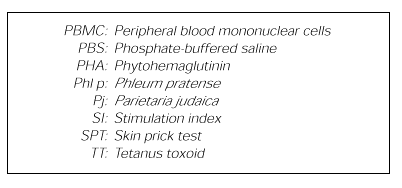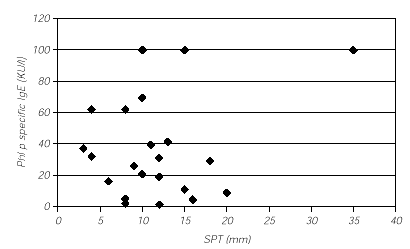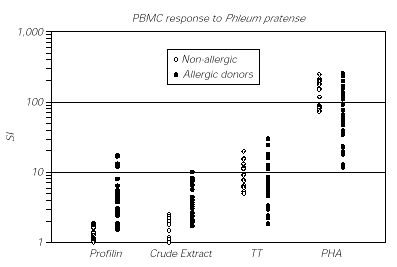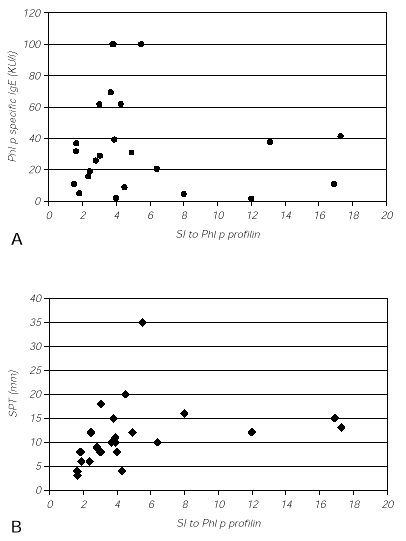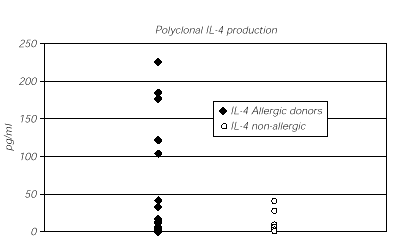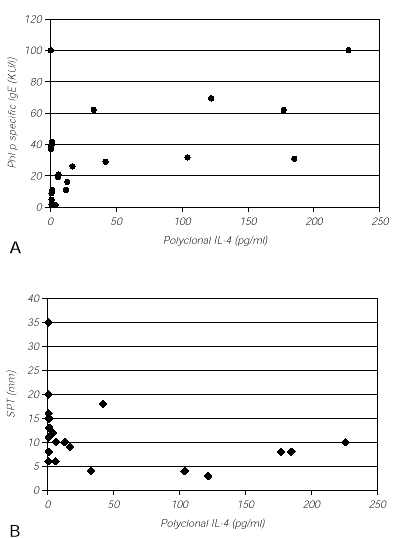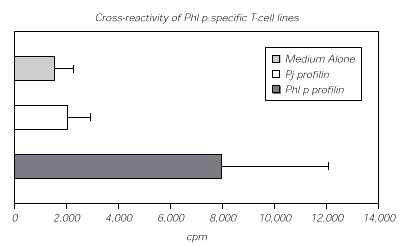INTRODUCTION
Pollen from Phleum pratense (Phl p) is a major airborne allergen worldwide, inducing seasonal rhinitis, conjunctivitis and asthma. Profilins constitute an ubiquitous family of proteins that control actin polymerization in eukaryotic cells (1) and have been identified as allergens in several species of tree, grass, and weed pollens and in some fruits and vegetables. Profilins are described as pan-allergens, because they are recognized by 20 % of all pollen-allergic patients (2-4) and have been considered for combined allergies to pollen and food (4).
It is well established that allergen-specific TH2-like cells play an important role in the induction of IgE synthesis (IL-4) and eosinophilia (IL-5) (5-7). Furthermore, a higher frequency of infiltrating T-cells producing TH1 cytokines (IFN-Υ) (8-10) and an increase in allergen specific IgG (11) are found after successful immunotherapy. This stresses the importance of different subsets of T-cells in the allergic immune responsiveness. Whereas skin prick test (SPT) results and allergen-specific IgE measurements are well correlated (12, 13), no relationship between allergen-specific T-cell proliferation, cytokine production, allergen-specific IgE, and SPT, has been found (14).
In this study we examine the specific immune response to Phl p plant profilin in allergic patients and non-allergic subjects. We analyze the possible correlation between allergen-specific T-cell proliferation, cytokine production, allergen-specific IgE and SPT in atopic patients to Phl p profilin and nonatopic donors. In addition, we address the question of the cross-reactivity between Phl p and Pj profilins.
MATERIAL AND METHODS
Characterization of blood donors
Blood samples from 26 Phl p allergic patients (mean age 24 years, range 19-28) and 18 nonatopic subjects (mean age 39 years, range 25-53) were collected. All patients had a clinical history of seasonal allergic rhinitis and/or asthma, positive SPT (> 4 mm of wheal diameter) to Phl p pollen extracts and to Phl p profilin, and all of them have positive serum Phl p pollen specific IgE (CAP-system, Pharmacia, Uppsala, Sweden) levels. None of the patients had received specific immunotherapy. Histamine chloryde, 10 mg/ml and saline were used as positive and negative controls, for skin test, in all subjects.
None of the control donors had a clinical history of allergic disease, and none had specific serum IgE or a positive SPT reaction to any of the common allergens of the Mediterranean area.
Allergens
Pollen from Phl p (Allergon AB, Välinge, Sweden) was extracted as previously described (15) and stored lyophilized at -20 °C until used. Working solutions (1 mg Iyophilized material/ml RPMI 1640 medium (BioWhittaker, Walkersville, Maryland) were stored at -20 °C until used. The extracts contained all important allergens as evaluated by sodium dodecylsulfate-polyacrylamide gel electrophoresis immunoblotting. Chromatographic purification of profilins was done as previously described (16). Proteins co-eluted with profilin were removed by high-resolution chromatography in the SMARTTM system (Pharmacia), as also described (16).
PBMC stimulation assay
PBMCs were isolated from freshly drawn heparinized blood by gradient centrifugation on Lymphoprep (Nycomed Pharma, Oslo, Norway), washed twice with PBS (bioMérieux, Marcy l'Etoile, France), and resuspended in X-VIVO 10 medium (BioWhittaker, Walkersville, Maryland) with L-glutamine, without antibiotics (referred to as medium). The PBMCs were stimulated with 10 mg/ml of Phl p profilin, in 96-well, round-bottomed plates with 1 ´ 105 cells/well in 200 µ/medium/well. Optimal conditions for the proliferation assays were determined by pilot studies with allergen concentrations from 100 to 0.01 µg/ml and harvest of the cells at day 3, 6 or 10 with PBMCs from patients and nonatopic donors. PBMCs in cultures without allergen were used as negative controls; PBMCs stimulated with 5 µg/ml tetanus toxoid (TT) (Rhône-Poulenc, Madrid, Spain) or with 1/100 PHA (Wellcome, Beckenham, U.K.) were used as positive controls. Cells were cultured for 6 days in a humidified atmosphere at 37 °C, 5 % CO2 followed by an 18-hour pulse in the presence of 0.5 mCi of 3H-thymidine (Amersham, U.K.) per well. The cells were harvested onto nitrocellulose filters and thymidine incorporation was determined by liquid scintillation counting (Betaplane, BTK, Wallack). Stimulation index (SI) values were calculated as the ratio of cpm at the optimal antigen concentration in the stimulated cultures relative to the cpm in the unstimulated cultures. All results represent the mean values of triplicate cultures.
Cytokine production
PBMCs were thawed and stimulated in medium with 25 µg/ml of Phl p profilin or 1/100 PHA (Wellcome, Beckenham, U.K.), in 96-well, flat-bottomed plates, 3 ´ 105 cells/well in 300 µ/medium/well were used. The cells were cultured in humidified atmosphere at 37 °C, 5 % CO2; PHA and Phl p profilin supernatants were collected at days 2 and 7 respectively. IL-4 and IFN-Υ concentrations in supernatants were determined by ELISA (Bender, Vienna, Austria) according to the manufacturer's description.
Establishment of Phl p specific T-cell lines
T-cell lines specific to Phl p profilin were established from PBMCs of 3 patients allergic to this profilin. Isolated PBMCs (1 ´ 106/ml) were stimulated in 8 ´ 1 ml bulk cultures in 24-well flat-bottomed culture plates (Nunc, Roskilde, Denmark) with 10 µg/ml of profilin for 7 days. Subsequently, recombinant IL-2 (rIL-2) (10 U/ml; Roche, Nutley, New Jersey, USA) was added and kept in culture for an additional 7 days.
T-cell stimulation assay
On day 14 after stimulation, the proliferative capacity of the T-cell lines was assessed: 2 ´ 104 T-cell blasts were incubated in triplicate 200-µ/ cultures in the presence of 105 irradiated (2,500 rads) autologous PBMCs plus the appropriate profilin (10 µg/ml) in 96-well round bottomed microtitter plates for 48 hr at 37 °C, in a humidified atmosphere of 5 % CO2, followed by an 18-hour pulse with 0.5 µCi of 3H-thymidine per well (Amersham), radionuclide uptake was measured by scintillation counting. Cultures with positive SI were selected.
Statistical analysis
Comparison of T-cell proliferation (expressed as SI) and cytokine production (expressed as pg/ml) between groups was done by Student's t test or Mann Whitney U test to compare groups of data with nonnormal distribution. Spearman rank order correlation was used to detect correlation between different data sets. All stochastic probabilities less than or equal to 0.05 were considered significant. Analyses were performed with SPSSWIN 6.1.3 (SPSS Inc., 1989-1995).
RESULTS
SPT and allergen-specific IgE
All patients had a positive SPT to both Phl p crude extract and Phl p highly purified profilin and all of them had Phl p specific IgE. No correlation was found between the patients' SPT wheal diameter (mean 11.3 ± 4.1 SD) and the concentration of serum specific IgE (Fig. 1). Total serum IgE levels ranged from 31 to 2,404 KU/ml (mean 330 ± 516.4 SD). Phl p specific IgE levels ranged from 1.4 to 100 KU/l (mean 36.1 ± 31 SD).
Figure 1.--SPT versus specific IgE. SPT results are expressed as Phl p profilin wheal diameter in mm. Phl p-specific IgE concentrations were determined in a CAP-system. (Pharmacia, Uppsala, Sweden) and expressed as KU/I. Spearman rank order correlation: r = 0.06, p = 0.78.
Proliferative T-cell responses to allergens
Both patients and controls exhibited proliferative T-cell responses to the allergen extract with maximal stimulation ranging 1 to 100 µg/ml. To ensure that the results were not influenced by the variation in background counts, they were expressed as SI. The responses expressed as mean SI to highly purified profilin were higher in the group of patients than in controls (Fig. 2). Proliferative responses to TT and PHA were higher in the group of controls than in patients, but the difference was not significantly (Fig. 2).
Figure 2.--Specific T-cell responses to profilin and crude extract from Phl p. Results are expressed as SI obtained by stimulation of PBMCs from patients (closed figures) or non-atopic controls (open figures). Mean values are significantly higher for Phl p profilin in atopics (mean 5.2 ± 4.5 SD) than in controls (mean 1.4 ± 0.3 SD) (p < 0.001). Also, mean values are significantly higher for Phl p crude extract in patients (mean 4.4 ± 2.5 SD) than in controls (mean 1.5 ± 0.6 SD) (p < 0.001). Mean values are non significantly higher for TT in controls (mean 11.4 ± 6.07 SD) than in patients (mean 9.6 ± 7.07 SD) (p = 0.403). Also, mean values are non significantly higher for PHA in controls (mean 158 ± 57 SD) than in patients (mean 83 ± 71 SD) (p = 0.361).
The level of profilin-specific T-cell proliferation did not correlate with specific Phl p IgE concentrations (Fig. 3A) or with Phl p profilin SPT (Fig. 3B) of the individual patients.
Figure 3.--(A). Specific T-cell responses to Phl p profilin versus specific IgE. Results are expressed as SI obtained by Phl p profilin stimulation of PBMCs from allergic patients and Phl p-specific IgE (KU/l). The IgE concentrations were determined in a CAP-system (Pharmacia, Uppsala, Sweden). Spearman rank order correlation: r = 0.69, p < 0.001. (B). Specific T-cell responses to Phl p profilin versus SPT. Results are expressed as SI obtained by Phl p profilin stimulation of PBMCs from allergic patients and Phl p profilin wheal diameter in mm. Spearman rank order correlation: r = 0.53, p = 0.008.
Cytokine profiles of the allergen-specific T-cell response
The production of IL-4 on PHA-stimulated PBMCs from allergic patients was higher than from controls (p < 0.001) (Fig. 4), whereas the production of IFN-Υ on the same conditions was higher in controls (p = 0.093, results not shown). The production of IL-4 and IFN-Υ by profilin-stimulated PBMCs was undetectable in the majority of patients and controls (results not shown). IL-4 polyclonal production level did not correlate with specific Phl p IgE concentrations (Fig. 5A) or the degree of Phl p profilin SPT response (Fig. 5B) in the allergic patients.
Figure 4.--IL-4 production by PBMCs of allergic patients (closed circles) versus controls (open circles). Polyclonal cytokine production: PBMCs were incubated with PHA (1/100) for two days and the concentration of IL-4 was determined by ELISA. Allergic patients produced higher levels of IL-4 (mean 40 ± 68 SD) than non-atopic controls (mean 5.63 ± 11 SD) (p < 0.001).
Figure 5.--Correlation between polyclonal IL-4 production and specific IgE (A) or SPT (B). Phl p-specific IgE concentrations were determined in a CAP-system. (Pharmacia, Uppsala, Sweden) and expressed as KU/I. The concentration of IL-4 was determined by ELISA, and expressed as pg/ml on the supernatants of the cultures of PBMCs from Phl p allergic patients stimulated with PHA (1/100) for two days. The Phl p profilin wheal diameter are expressed in mm. Spearman rank order Correlation: A: r = 0.16, p = 0.474. B: r = - 0.41, p = 0.054.
Cross-reactivity of Phl p and Pj profilins
No cross-reactivity with another highly purified profilin (Pj profilin) (Fig. 6) was observed in the 8 Phl p profilin specific T-cell lines raised from the PBMCs of three patients.
Figure 6.--Reactivity of Phl p profilin specific T-cell lines with a highly homologous profilin from Pj. Fourteen T-cell lines were established from the PBMCs of three Phl p profilin allergic patients. Results are expressed as the mean of cpm of triplicate cultures, stimulated with Phl p profilin (mean 7,947 ± 4,133 SD), Pj profilin (mean 2,040 ± 900 SD), or medium alone (mean 1,531 ± 742 SD).
DISCUSSION
The main findings of our study are: (1) The patients allergic to Phl p profilin had a significantly increased T-cell proliferative response to this profilin compared with nonatopic subjects. (2) The enhanced T-cell proliferation of the allergic patients could not be correlated to the degree of skin reactivity or to specific serum IgE levels. (3) Specific Phl p profilin T-cell lines did not show cross-reactivity with another highly purified profilin (Pj profilin). (4) The group of allergic patients has a significantly increased polyclonal (PHA) production of IL-4, compared with nonatopic subjects and (5) this increased production of IL-4 did not correlate with skin reactivity or specific serum IgE levels.
The enhanced T-cell responses to profilins in the allergic patients indicate an increased frequency of allergen-specific T-cells (17). The fact that enhanced profilin specific T-cell responses are found in the peripheral blood of patients with allergies suggests that the responding T-cells are inducing the production of the allergen specific IgE by B cells and the subsequent skin reactivity. Therefore a direct correlation between the level of T-cell reactivity and allergen-specific serum IgE and SPT response could be expected. However, in this study neither specific serum IgE levels nor SPT could be correlated to the level of profilin specific T-cell responses of the individual patients. In a similar study Würtzen et al. (14) working with grass allergen extracts and immunoaffinity-purified group 5 allergens of the Poaceae family (Phl p, Poa pratensis, Lolium perenne) reached very similar conclusions. They also did not find any correlation between the magnitude of the patients' T-cell responses and the skin prick test or specific serum IgE levels.
We were unable to detect the production of IL-4 (a typical TH2 cytokine) and IFN-Υ (a typical TH1 cytokine) when PBMCs from allergic patients and nonatopic controls were stimulated by Phl p profilin because the levels of the cytokines in the supernatants of the cultures were too low for the sensitivity of the method. However, the increased production of IL-4 and the tendency to a reduced production of IFN-Υ, due to a polyclonal stimulation (PHA) of peripheral T-cells of the allergic patients, reflects their allergic phenotype. Several investigators have reported cytokine production patterns in PBMCs activated by non-specific stimulation in allergic diseases. It was shown that in vitro IFN-Υ production by PHA-stimulated PBMCs is greatly diminished in atopic dermatitis patients compared with nonatopic healthy controls (18). In addition, it has also been demonstrated that the activation of PBMCs from atopic patients with high serum IgE induce higher levels of IL-4 synthesis and lower levels of IFN-Υ than the levels produced by PBMCs from healthy controls, suggesting that enhanced IL-4 production and reduced IFN-Υ production are associated with the elevated serum IgE levels in patients (19, 20).
Recently, several plant profilins has been cloned and sequenced (21-25). In fact, there is a 76.5 % of homology between Pj and Phl p profilins. In the selected Phl p profilin specific T-cell lines with better Sl re-stimulated with Phl p or Pj profilins no cross-reactivity with Pj profilin was observed. Even though these data were obtained from experiments with a limited number of T-cell lines, the results indicate the importance of using T-cell lines (or clones) and highly purified (or recombinant) allergens in order to stablish the cross-reactivity between allergens at the T-cell level.
In conclusion, the results of our work show that Phl p profilin specific proliferative T-cell response and the polyclonal production of IL-4 are higher in patients than in controls. This result suggests a role for Phl p profilin in the induction of T-cell driven immunological reactions. The lack of correlation between the skin reactivity and IgE specific concentration, T-cell reactivity or IL-4 production level is most likely to reflect the complexity of the skin reactivity, whereas the fact that the proliferative T-cell response did not correlate to the patients serum IgE indicates that at least some of the responding T-cells may be involved in immune reactions other than the support of IgE production. Phl p profilin specific T-cell lines did not show cross-reactivity with a highly homologous profilin from Pj.
ACKNOWLEDGMENTS
This work was supported by FISS 96/0787. The hrIL-2 used in this study was kindly provided by Dr. M. Gately (Hoffmann-La Roche, Nutley, New Jersey, USA).



